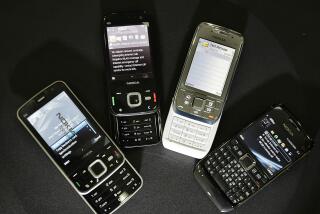Cellphone exec takes up a new calling
- Share via
WASHINGTON — Most people take a vacation to get away from their jobs. Cyriac Roeding took a vacation for his job.
Instead of relaxing on a beach, Roeding -- a mobile technology expert and enthusiast -- took a ‘round-the-world odyssey to see how the rest of the world uses cellphones. He saw parking meters that talk to phones in New Zealand, teenage text-messaging monks in a Himalayan monastery and cellphone-charging stations along the Ganges River in India, right next to a raging funeral pyre.
Roeding, 35, quit as executive vice president of CBS Mobile in March after leading the new division of the media giant through its first three years and creating cellphone-based products for the company, home to shows such as the “CSI” franchise.
Roeding, who had founded a mobile business in Germany before coming to CBS, said he quit the network because he tends to work on projects, and once CBS Mobile was up and running he was ready for a new start-up. Before he began a new project, Roeding felt the need to “expose myself to a lot of uncomfortable situations and take myself out of my cozy little life,” he said in a recent interview.
He and his girlfriend drew up a list of places they wanted to visit. The list’s destinations were more than just a desire to see exotic scenery: He wanted to see how cellphones were being used in parts of the world he’d never dealt with while working at CBS.
“I need input,” Roeding thought at the time.
The result was a jaunt that began July 8 in Los Angeles and wrapped up there Aug. 20. Roeding and his girlfriend went to Fiji, New Zealand, Singapore, India, Bhutan, Nepal, Thailand, South Africa, Brazil and Costa Rica. He declined to give the cost of the trip.
Roeding’s take-away from his circumnavigation (other than an ear infection): “I have known how important mobile is for some time now, but I’ve got to tell you, I was personally surprised and sometimes shocked at how far the use of mobile goes,” he said. “It actually surprised me that mobile is reaching to the very edges of the world.”
By late last year, global cellphone penetration had reached 50%, research firm Informa said. Worldwide sales of cellphones rose 12% in the second quarter of 2008, compared with the same period last year, according to Gartner Research. The biggest gain came in the Asia-Pacific market, where sales rose 21% and where Roeding spent much of his trip.
In the countries Roeding visited, texting generally is more widespread than talking because it’s cheaper. Cellphones often include AM/FM radios. Because of the high cost of data transmission, mobile Web browsing is only beginning to catch on in poorer countries.
Even though most cellphone keypads are in English, non-English speakers are using the letters of the English alphabet as symbols for words and phrases in their own languages, much the way the Japanese use the Chinese kanji.
What all this means for businesses is clear, Roeding said: Companies that want to offer mobile service should be “pure-play” mobile and not try to create content, services and devices for both mobile and PC-based media. In most of the developing world, personal computers and laptops are nonexistent; the mobile device is king and might remain so.
Poorer countries typically have not built extensive land-line telephone infrastructure and might never do so. But cellphone use is pervasive, meaning those countries have leapfrogged over what industrialized nations have always assumed is a necessary step in technological growth. In some countries, another leap is about to take place, as WiMax rollout begins, enabling fast mobile Web browsing.
During his trip, Roeding saw things that surprised even a mobile veteran like himself, such as:
In the Himalayan kingdom of Bhutan, consumer adoption of cellphones has followed the same arc it did in the U.S.: Cellphones were initially marketed for personal safety. They became a business when consumers began using them for recreational means, such as texting.
At the Tiger’s Nest Buddhist monastery, at an elevation of 10,200 feet, Roeding saw a 14-year-old monk on a cellphone speaking to his family in another part of the country. Before he got the cellphone, the young monk said, he could never communicate with his family. But now, he said, he spends most of his time texting with other monks.
In Nepal, ring tones are the rage. Roeding saw a group of boys squatting around a cellphone in a street. They told him they were listening to the various ring tones in the phone, the way others might listen to songs on an iPod.
Cellphones played a key role in the recent Maoist insurgency against the Hindu monarchy, allowing protesters to quickly organize. They became so effective as a tool of the opposition that the government tried to ban texting twice. During spring elections, the Maoists sent texts to voters: “A new thinking and leadership for a new Nepal. . . . Give Maoists a chance this time.”
In South Africa, personal-injury lawyers have an infomercial television show that tells viewers to text the show and within 48 hours a lawyer will call. At airports, new arrivals are handed “text and win” sweepstakes sign-ups.
In some ways, Roeding found, the U.S. lags behind poorer countries in cellphone savvy. “Here, we think it’s cool to announce the vice president by text messaging,” he said. “In other countries, there wouldn’t be any other way except by newspapers.”
Roeding will take his recently acquired input to his new job, which he begins in two weeks: entrepreneur-in-residence for the Silicon Valley venture capital firm Kleiner Perkins Caufield & Byers, coming up with ideas for mobile-based businesses. KPCB recently partnered with Apple Inc. to create the $100-million “iFund” to invest in new applications and products for the iPhone.
More to Read
Inside the business of entertainment
The Wide Shot brings you news, analysis and insights on everything from streaming wars to production — and what it all means for the future.
You may occasionally receive promotional content from the Los Angeles Times.










